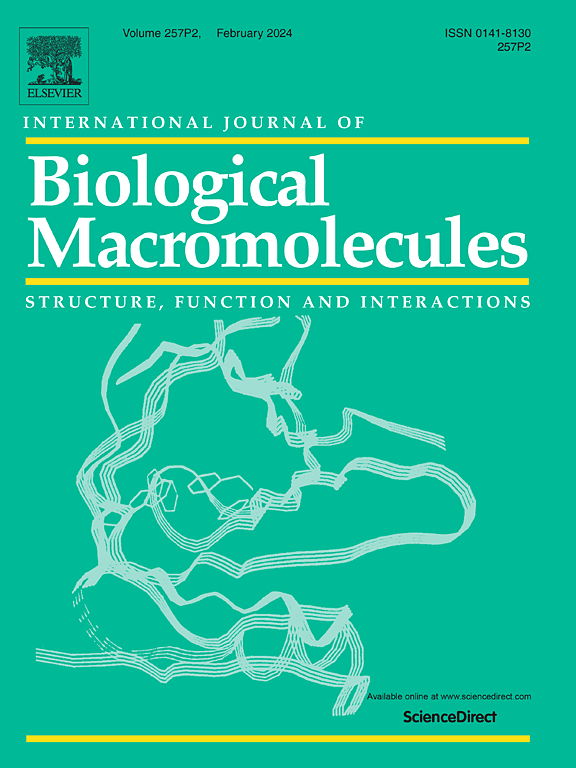Micropolymorphism outside the peptide-binding groove of human leukocyte antigen (HLA)-C*14 modulates structural stability and shapes immune responses
IF 7.7
1区 化学
Q1 BIOCHEMISTRY & MOLECULAR BIOLOGY
International Journal of Biological Macromolecules
Pub Date : 2025-04-02
DOI:10.1016/j.ijbiomac.2025.142772
引用次数: 0
Abstract
Micropolymorphisms in human leukocyte antigen class I (HLA–I) molecules critically influence antigen presentation and immune recognition. Most studies have focused on variations within the peptide-binding groove (PBG), neglecting the potential impact of residues located outside this region. HLA-C*14:02 and HLA-C*14:03 differ only at position 21 (R21 and H21, respectively), which is situated outside the PBG, yet these two allotypes exhibit distinct clinical associations with HIV control in the context of KIR2DL2, an inhibitory killer cell immunoglobulin-like receptor that modulates natural killer (NK) cell activity. Here, we investigated the molecular mechanisms by which the R21H micropolymorphism shapes immune responses. Structural and biochemical analyses revealed that position 21 indirectly regulates the conformation of the B pocket within the PBG, significantly affecting HLA-C*14 stability and altering the composition of its peptide repertoire, while preserving core peptide motifs and recognition by KIR2DL2. Notably, the R21H variation is evolutionarily conserved across various HLA-I molecules and exhibits similar interactions with neighboring residues, suggesting a broadly conserved role in structural stability and immune regulation. These findings suggest that the stability differences between HLA-C*14 allotypes may influence their differential clinical associations, highlighting the previously underappreciated role of micropolymorphisms outside the PBG in modulating immune responses.
人类白细胞抗原 I 类(HLA-I)分子中的微多态性对抗原呈递和免疫识别有着至关重要的影响。大多数研究都侧重于肽结合沟(PBG)内的变异,而忽视了位于该区域外的残基的潜在影响。HLA-C*14:02和HLA-C*14:03仅在第21位(分别为R21和H21)存在差异,该位置位于PBG之外,但这两种异型在KIR2DL2(一种抑制性杀伤细胞免疫球蛋白样受体,可调节自然杀伤细胞(NK)活性)的背景下表现出与HIV控制不同的临床关联。在这里,我们研究了 R21H 微多态性影响免疫反应的分子机制。结构和生化分析表明,位置 21 间接调节了 PBG 内 B 袋的构象,显著影响了 HLA-C*14 的稳定性并改变了其肽库的组成,同时保留了核心肽基序和 KIR2DL2 的识别。值得注意的是,R21H变异在各种HLA-I分子中都是进化保守的,并与邻近残基表现出相似的相互作用,这表明它在结构稳定性和免疫调节中起着广泛保守的作用。这些研究结果表明,HLA-C*14 allotypes 之间的稳定性差异可能会影响它们之间不同的临床关联,从而凸显出 PBG 之外的微多态性在调节免疫反应中的作用以前一直未得到重视。
本文章由计算机程序翻译,如有差异,请以英文原文为准。
求助全文
约1分钟内获得全文
求助全文
来源期刊
CiteScore
13.70
自引率
9.80%
发文量
2728
审稿时长
64 days
期刊介绍:
The International Journal of Biological Macromolecules is a well-established international journal dedicated to research on the chemical and biological aspects of natural macromolecules. Focusing on proteins, macromolecular carbohydrates, glycoproteins, proteoglycans, lignins, biological poly-acids, and nucleic acids, the journal presents the latest findings in molecular structure, properties, biological activities, interactions, modifications, and functional properties. Papers must offer new and novel insights, encompassing related model systems, structural conformational studies, theoretical developments, and analytical techniques. Each paper is required to primarily focus on at least one named biological macromolecule, reflected in the title, abstract, and text.

 求助内容:
求助内容: 应助结果提醒方式:
应助结果提醒方式:


